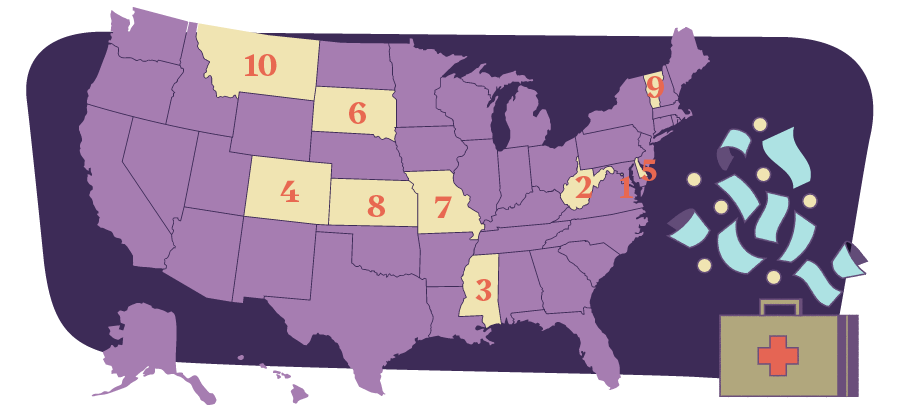
Are you a locum tenens physician interested in increasing your income? You might want to consider an assignment in one of these top-paying states for locum tenens physicians. We sourced data from two of the largest locum tenens staffing agencies in the United States to identify areas that offer above-average compensation rates for locum tenens roles.
Here’s this year’s list of the top ten highest-paying states for locum tenens and the factors contributing to these elevated pay rates.
1. District of Columbia: 130%
Newcomer to the list of the top-paying states for locum tenens, the District of Columbia (DC), clinched this year’s highest earning spot. DC pays 130% compared to the national median, due in large part to physician shortages. According to the DC Department of Health (DOH), the District has nine designated Health Professional Shortage Areas and eight Medically Underserved Areas/Populations. In a relatively small geographic area — DC is just over 68 square miles — these health professional shortages and medically underserved areas represent a large portion of the population.
To address these shortages, DC is investing in and expanding services in underserved areas, including over $90 million for the construction of new healthcare sites and approximately $3 million into DC’s loan repayment program that assists with recruiting and retaining healthcare providers to serve in underserved areas. In addition, the DOH provides operational support for nine community and school-based health centers to ensure access to care in underserved areas.
2. West Virginia: 128%
West Virginia compensates locum tenens physicians at a rate that is 128% of the median pay nationwide. As with many states on this year’s list, the demand for locum physicians correlates with the state’s severe physician shortage. According to the West Virginia Hospital Workforce Report 2023, the state is facing “significant” healthcare workforce shortages due to declining college enrollment, increased burnout, an aging workforce with fewer people entering healthcare fields overall, and COVID-19. The West Virginia Hospital Association is licensed for 6,500 beds. Due to staffing shortages, they can only offer 4,500 beds to West Virginia patients, causing delays in procedures and care.
The report further identified 11 critical professions — including diagnostic imaging, medical laboratory, and respiratory therapy roles, among others — that have an overall vacancy rate of 18.6% and a turnover rate of 24.3%
State leaders are quick to credit locum physicians and other travel healthcare professionals with helping West Virginia avoid closing healthcare facilities at a rate some other states have experienced.
3. Mississippi: 127%
Another state also facing a persistent healthcare crisis, Mississippi has healthcare shortage rates well above the national average. According to a 2021 assessment from the Mississippi Department of Health, 80 of the state’s 82 counties are federally classified as health professional shortage areas.
The concern is punctuated by a severe physician shortage. Mississippi currently ranks 50th in physician-to-population ratio in overall physicians. The state has just 67.4 active primary care physicians per 100,000 population, compared to a U.S. median of 94.7.
4. Colorado: 124%
Colorado also faces a dire physician shortage. While COVID-19 magnified healthcare staffing needs in Colorado, some counties across the state registered zero physicians per 100,000 residents, even pre-pandemic. Colorado is expected to need an additional 1,773 primary care physicians by 2030, particularly in rural settings. And certain specialties — including OB/GYN, anesthesiology, and internal medicine — are in especially high demand.
Physicians who take locum tenens assignments in Colorado stand to earn an average of 124% of the national median for locums pay.
5. Delaware: 122%
Delaware climbed five spots on this year’s list (from 10th in 2022) of highest-paying states for locum providers, compensating its locum tenens physicians at a rate of 122% of the national median.
Delaware is one of just four states without its own medical school. As a result, the state does not benefit from newly trained physicians who stay in the state to practice. The state is also impacted by an aging healthcare workforce: Nearly 30% of physicians in Delaware say they’re planning to retire within the next five years.
6. South Dakota: 120%
There are many factors contributing to the lack of access to medical services in South Dakota. Many medical services in the state are geographically concentrated along the Interstate 29 corridor, the Central Missouri River region, and the Black Hills area — rendering wide swaths of the state’s rural population without access to even primary care, let alone specialized care.
South Dakota’s harsh winter climate can also make it difficult to recruit locum tenens physicians during critical months. To offset these factors, South Dakota offers competitive locum tenens pay at 120% of the national median.
7. Missouri: 118%
Missouri is among the states facing a physician shortage, contributing to its higher-than-average locum tenens physician rates. Despite population growth, nearly one-third of the state’s rural hospitals are at risk of closure. Nearly every county in Missouri suffers a shortage of primary care providers, according to the Federal Health Services and Resources Administration.
State lawmakers are investing in new medical residency programs in Missouri to help encourage physicians to stay in the state when they’ve completed their medical training. The state also surpasses the national average for locum tenens compensation, at 118% of the median pay.
8. Kansas: 118%
Like most states on this list, Kansas faces a severe physician shortage: Out of 105 counties in Kansas, 92 counties are medically underserved, according to the most recent report from the Kansas Health Science Center. To help address the need, locum tenens providers are well compensated at 118% of the national average pay.
As with many other states, the shortages are most keenly felt in Kansas’ vast rural regions. According to the report, despite efforts to increase the number of providers in the state, professional shortages and a changing healthcare marketplace perpetuate uneven distribution of these essential healthcare professionals across the state. As a result, being underserved or having too few professionals for area residents continues to be a predominantly rural problem.
9. Vermont: 117%
Vermont broke into the top 10 highest-paid states for locum tenens in 2022 and maintains a spot on the list for 2023.
Despite a higher-than-average physician-to-population ratio (by some estimates, Vermont ranks 4th highest in the nation), Vermont is facing a critical shortage of primary care physicians, forcing patients to seek emergency medical care for non-emergencies. According to the Vermont Medical Society, primary care — or lack thereof — is the most pressing issue facing the state.
Primary care physicians interested in locum tenens roles could have a significant impact — and earn above the national average — in Vermont.
10. Montana: 117%
New to the list of top-paying states for locum tenens, Montana comes in at number 10. With its vast rural areas and aging population, Montana is facing an unprecedented healthcare worker challenge.
People living in the state’s frontier and rural communities often live hours from medical services. According to the Montana Department of Health and Human Services, 51 of the Treasure State’s 56 counties are considered medically underserved. In fact, some counties don’t have a physician at all.
Add to this an aging population and physician workforce — Montana has the 4th oldest physician workforce in the country — and it’s understandable why the state is willing to pay a premium for excellent locum tenens support.
Working locum tenens can be a lucrative career choice, especially for locum tenens providers who are willing to work assignments in high-need and rural locations. These locations also offer an important setting to deliver care to areas and populations in greatest need.

